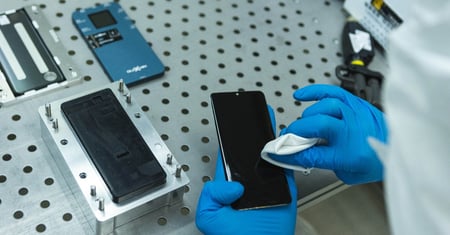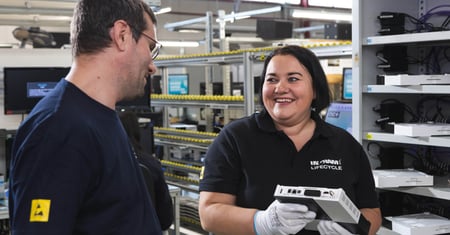If you’re struggling to keep up with the volume of product returns your business is facing, you may be facing financial implications and customer dissatisfaction. This can have a huge impact on your profitability.
With more than a decade of experience, Ingram Micro Lifecycle has developed meticulous returns management programs that support multiple product categories. Our skilled technicians become product experts, learning your products inside and out. Through our diverse technical knowledge of the industry and of your product, we can provide detailed feedback from product returns, improve sustainability, and lower costs.
This article demonstrates how a returns management program can alleviate common product faults through efficient parts management.
What are the common SDA faults?
A recent Which? report highlighted common issues with Small Domestic Appliances (SDAs), as reported by consumers. The survey focused on the product categories below:
- Microwaves
- Kettles
- Coffee machines
- Toasters
- Food processors
- Blenders
The summarising report included a ranking of key brands referenced in the survey, along with common faults of the product type, and named the best overall brand and the value alternative.
The common faults experienced by consumers, by product category, were:
- Coffee machine
- Issues dispensing coffee
- Issues with leaking
- Element stopped working (no heat)
- Kettles
- Element stopped working
- Faulty/broken lid
- Limescale problems
- Food processors
- Broken attachment (paddle, knife blade)
- Broken or damaged power cable/plug
- Blade broken
- Blenders
- Broken or damaged power cable/plug
- Blade broken
- Broken blending jug/cup
You can grab a free download summarizing these findings at the end of this article.
How common faults impact returns management
Product returns can be an unavoidable part of sales, but it can be an opportunity. Rather than letting the returns stack up, you need efficient processing to determine the necessary repair and refurbishment. By recovering the function of the products, you can turn these into a revenue stream via recommerce.
The biggest blocker for recovering returned products is parts accessibility. Failing to have the appropriate parts causes an inability to complete repairs.
Achieving OEM accreditations
Through accreditations from Original Equipment Manufacturers, the repair partner will have access to genuine replacement parts and accessories. They’ll have been audited by the OEM to show they can meet the required high standards in completing repairs. As well as access to parts, the partner will utilize manufacturer-approved instructions, repair guides, and processes. The technicians will have been trained to deliver repairs to the manufacturer’s quality requirements.
Enabling a circular economy
By restoring returned products, you’re prolonging their useful life through repair and refurbishment tactics. This is supporting the circular economy as a used product can be re-used.
If you’re committed to enabling a circular economy as part of your sustainability objectives, failing to find the parts to recover goods will limit the lifecycle extension you can achieve.
Harvesting reusable parts
When assessing returned products to determine faults, where repairs of the whole unit aren’t economically feasible, parts and components can instead be harvested for reuse. Despite the inability to save the entire product, you can minimize waste by recovering what you can.
Accurately identifying harvestable parts and separating them enables cost reductions in acquiring new parts. It’s much more sustainable, relieving pressure on the manufacturing of new components, and consuming less raw materials. It also reduces waste because more parts are being reclaimed rather than heading to landfill.
Part of this process must include deep cleaning of products. This is particularly important for SDAs, such as air fryers or vacuums. Parts must be in a hygienic condition before re-use. Otherwise, onward purchasers will be dissatisfied with the quality of the products, and these may not have the same longevity as cleaned products. This deep cleaning must be intensive and timely, to ensure it doesn’t delay the processing of the product for recovery.
Maintaining a live inventory
After parts harvesting, you need to keep an efficient live inventory of components and accessories you have to hand. These should note whether the part is brand new or harvested. Using more harvested parts will boost the carbon offsetting of your repair and refurbishment activities.
Ensuring this is a live record enables you to call our parts as and when needed, improving the management and efficiency of the process, and removing any delays associated with the sourcing and logistics of obtaining parts.
Obtaining in-depth product knowledge
When assessing returned products, you need to have a diverse knowledge of the components and what makes the product work to find faults and fix them. A skilled technical approach is required to ensure an accurate, efficient outcome quickly. This includes having an innovative approach to problem-solving and thinking outside the box to create sustainable solutions. The components need to be seen as individual elements as well as larger parts of the whole – one fix may not apply to all products and technicians need a wide knowledge to be able to propose new ideas that must be scalable and repeatable.
Returns avoidance – tackling high return rates
Returns avoidance strategies can pose a solution to lowering high return volumes. This empowers the end-user customer to self-diagnose a problem. If the user can determine the issue accurately, you can organize a replacement part for them. Extended logistics and time delays are avoided as you don’t require the physical product to be sent to you for assessment, exchange, or refund.
Returns avoidance can boost customer satisfaction as the associated downtime is minimized – it’s a quicker experience to receive a single replacement part directly, rather than needing to send off a whole product for assessment.
Fault data must be fed between the customer support and repair teams. This informs on commonly identified issues and best advice for end users on how to fix or identify product faults themselves. Sometimes a problem can be a perceived issue or misunderstanding, easily avoided with helpful support from a contact center.
Streamline your parts management to improve returns processing
Faults are part and parcel of selling products. Nothing can be perfect but you can mitigate customer dissatisfaction and improve the sustainability of your product returns.
Ingram Micro Lifecycle operates returns avoidance for customers as part of an end-to-end returns management solution. Our services enable the repair and refurbishment of returned goods, maximizing the potential for value recovery on the secondary market. Our technical contact center provides direct-to-user liaison and support, offering guidance and advice for those with product issues.
Get your downloadable infographic summarizing the top Small Domestic Appliance faults here, or contact us to discuss how we can support streamlining your returns management program.













